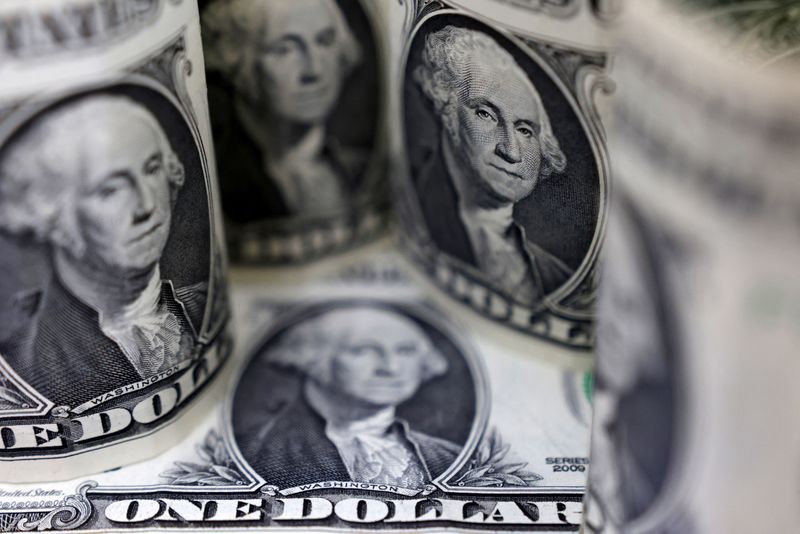Dollar wavers near 7-month low on rate cut bets, Powell speech in focus
By Ankur Banerjee
SINGAPORE (Reuters) -The dollar wobbled near a seven-month low on Tuesday on wagers the U.S. central bank will start cutting interest rates from next month, with traders bracing for comments from Federal Reserve Chair Jerome Powell on Friday.
The weakness in the dollar lifted the euro to its highest this year, while sterling was perched near a one-month peak. The MSCI's emerging markets currency index also hit a record high.
The focus this week will be on Powell's speech in Jackson Hole, likely keeping investors hesitant in placing major bets before the event. Minutes of the Fed's last meeting due to be released on Wednesday will also be in the spotlight.
Investors largely expect Powell to acknowledge the case for a rate cut and will parse his words for cues on whether the Fed will start with a 25 basis point cut or a 50 bps cut in September.
While labour market deterioration led to the markets expecting a bigger rate cut in September, data since has been mixed with upbeat retail sales still signalling a resilient consumer, said Charu Chanana, head of currency strategy at Saxo.
"This could keep Powell wary of sending a strong signal on the magnitude of the first rate cut. Also, any clear risks of a larger rate cut could also signal a policy mistake from the Fed and higher recession risks."
Markets are pricing in a 24.5% chance of a 50 bps cut in September, down from 50% a week ago, with a 25-basis-point reduction having odds of 75.5%, the CME FedWatch Tool showed. Traders are pricing in a total of 93 bps of cuts this year.
A slim majority of economists polled by Reuters expect the U.S. central bank to cut rates by 25 bps at each of the remaining three meetings of 2024.
The euro last fetched $1.10775 on Tuesday having touched $1.108775, its highest since Dec. 28 in early trading. The single currency is up 2.4% this month, on course for its strongest monthly performance since November.
The pound was steady at $1.2979 in Asian hours after touching a one-month high of $1.2998 in the previous session.
The dollar index , which measures the U.S. currency against six rivals, was last at 101.95 after touching its lowest since Jan. 2 of 101.82 earlier on Tuesday. The index is down more than 2% in August and set for a second month in the red.
The U.S rate cut expectations also lifted the Australian and the New Zealand dollars near their one-month highs. The Aussie last fetched $0.6719, while the kiwi was at $0.61205.
UEDA AWAITED
The Japanese yen was slightly weaker at 146.98 per dollar, still close to the near two-week high it touched in the previous session but grinding away from the seven-month high of 141.675 it touched at the start of August.
Bouts of intervention by Tokyo at the start of last month and a surprise rate hike have pulled the yen away from the 38-year lows of 161.96 it was stuck at in early July and wrong footed investors who sharply cut their bets against the yen.
Investor attention will be on Bank of Japan Governor Kazuo Ueda when he appears in parliament on Friday. Ueda is expected to discuss the BOJ's decision last month to raise rates and the focus will be on whether he sticks to his recent hawkish tone.
Claudio Wewel, currency strategist at Bank J. Safra Sarasin, said the yen's pace of appreciation will likely be more gradual as the data shows most speculative short positions have been cleared.
The latest weekly data to Aug. 13 showed that leveraged funds - typically hedge funds and various types of money managers - flipped their long-standing short yen position and are now net long for the first time since March 2021.
"We expect USD-JPY to trade at around its current level near term, while we expect the pair to gravitate to 140 as the year ends," Wewel said in a note.
Source: Investing.com
